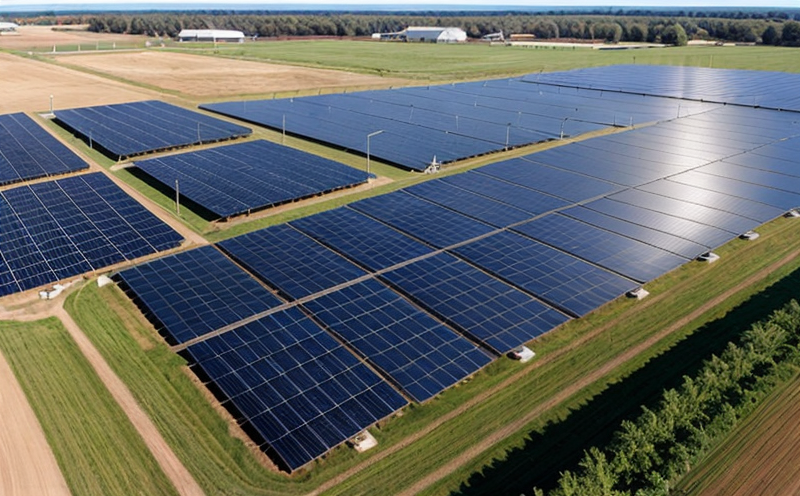ASTM G154 UV Weathering Testing for New Renewable Materials
The ASTM G154 standard provides a method to determine the effects of ultraviolet (UV) light, heat, and moisture on the performance of new renewable materials. This test is critical in the energy sector as it helps ensure that innovative materials used in photovoltaic systems, wind turbine components, and other renewable energy applications can withstand environmental stresses over their operational lifetimes.
ASTM G154 simulates the effects of sunlight exposure by using a combination of UV radiation, moisture cycling, and heat. This accelerated testing allows manufacturers to identify potential issues early in the product development cycle, thereby improving durability and reliability before full-scale commercialization. The test protocol is based on international standards such as ISO 4892-3:2015, which provides guidance for laboratory determination of weathering resistance.
The testing process involves exposing specimens to controlled conditions designed to replicate the effects of natural sunlight over time. The UV light source typically used in ASTM G154 is xenon arc lamps that emit a spectrum similar to that of the sun, ensuring accurate simulation of real-world exposure. Specimens are placed in a chamber where they undergo cycles of irradiation and humidity. This mimics the environmental conditions that would normally be experienced by materials exposed outdoors.
Post-testing analysis includes examining changes in material properties such as color fastness, tensile strength, and flexibility. These parameters help determine whether the material has degraded beyond acceptable limits or maintained its integrity throughout the testing period. The results of ASTM G154 are invaluable for quality managers, compliance officers, R&D engineers, and procurement teams responsible for ensuring that new renewable materials meet stringent performance standards.
Testing according to ASTM G154 ensures compliance with international regulations and industry best practices while providing valuable insights into the long-term performance expectations of newly developed materials. By incorporating this testing method early in the design phase, manufacturers can make informed decisions about material selection and formulation, ultimately leading to more robust products capable of enduring harsh environmental conditions.
One key advantage of ASTM G154 is its ability to provide rapid results compared to outdoor exposure tests which could take years. This accelerated approach allows for quicker product iterations and improvements before large-scale production begins. Additionally, the controlled environment ensures consistent testing conditions across different samples, reducing variability often seen in field trials.
For quality managers looking at long-term durability data, ASTM G154 offers a reliable method to assess how well their materials will perform under various environmental stresses. Compliance officers can use these test results to meet regulatory requirements and ensure that their products are safe and effective for intended uses. R&D engineers benefit from early identification of material weaknesses or strengths during development stages. Lastly, procurement teams gain confidence knowing they are selecting suppliers whose products pass rigorous quality checks.
Understanding the nuances behind ASTM G154 helps stakeholders appreciate its importance in validating new renewable materials. Through careful planning and execution, laboratories like Eurolab can deliver accurate and consistent results that contribute significantly to advancing sustainable energy solutions.
Eurolab Advantages
EuroLab stands out as a leader in renewable materials testing, offering comprehensive services tailored specifically for the needs of industry professionals involved in developing cutting-edge technologies. Our state-of-the-art facilities equipped with advanced instrumentation allow us to conduct ASTM G154 tests under strictly controlled conditions ensuring accuracy and reliability.
Our experienced team of technicians brings decades of combined experience in materials science, making them uniquely qualified to interpret results accurately and provide actionable recommendations based on findings from ASTM G154 testing. We also offer additional support services such as consultation on best practices for material selection or assistance in preparing samples correctly prior to testing.
At EuroLab, we understand the importance of staying current with evolving standards and technologies within the renewable energy sector. That’s why we continuously invest in training our staff while keeping abreast of new developments through ongoing education programs. This commitment ensures that our clients receive up-to-date information regarding best practices for testing their materials.
Moreover, our strong reputation among major players in the industry has enabled us to build trusted relationships built on integrity and transparency. Clients can trust that when working with EuroLab, they are partnering with experts who prioritize quality over quantity, delivering consistent high standards every time.
Competitive Advantage and Market Impact
EuroLab's expertise in ASTM G154 UV weathering testing for new renewable materials provides a significant competitive advantage. Our ability to deliver accurate, reliable test results within a short timeframe allows our clients to stay ahead of the competition by ensuring their products meet or exceed quality standards before market launch.
The early identification of material weaknesses through rigorous ASTM G154 testing enables manufacturers to refine designs and improve product performance without costly rework later in production cycles. This agility translates directly into increased efficiency, reduced time-to-market, and enhanced customer satisfaction—all critical factors in today’s competitive marketplace.
From a strategic perspective, EuroLab's role in validating new renewable materials plays an essential part in driving innovation within the industry. By setting benchmarks for what constitutes acceptable performance under extreme environmental conditions, we help pave the way towards more sustainable energy solutions. As regulatory requirements evolve to address climate change challenges, having reliable testing methodologies like ASTM G154 becomes even more crucial.
Our reputation as a trusted partner in renewable materials testing is further enhanced by our commitment to sustainability ourselves. By conducting our operations with minimal environmental impact, we demonstrate leadership not only in product quality but also in corporate responsibility. This aligns perfectly with the values of many of our clients who are committed to greener practices across their entire supply chains.
In summary, EuroLab's proficiency in ASTM G154 UV weathering testing for new renewable materials is more than just a service—it represents an investment in future growth opportunities and market leadership. Our comprehensive approach ensures that every aspect of the testing process—from sample preparation to final reporting—is conducted with precision, ensuring clients receive the most valuable insights possible.





